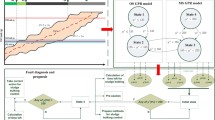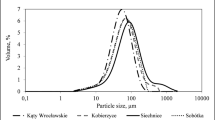Abstract
The performance of the activated sludge process is limited by the ability of the sedimentation tank (1) to separate the activated sludge from the treated effluent and (2) to concentrate it. Apart from bad operating strategies or poorly designed clarifiers, settling failures can mainly be attributed to filamentous bulking. Image analysis is a promising technique that can be used for early detection of filamentous bulking. The aim of this paper is therefore twofold. Foremost, correlations are sought between image analysis information (i.e., the total filament length per image, the mean form factor, the mean equivalent floc diameter, the mean floc roundness and the mean floc reduced radius of gyration) and classical measurements (i.e., the Sludge Volume Index (SVI)). Secondly, this information is both explored and exploited in order to identify dynamic ARX and state space-type models. Their performance is compared based on two criteria.









Similar content being viewed by others
Notes
volume in milliliters occupied by 1 g of a suspension after 30 min settling
References
Banadda EN, Jenné R, Smets IY, Van Impe JF (2003) Predicting the onset of filamentous bulking in biological wastewater treatment systems by exploiting image analysis information. In: Proceedings of the European control conference, CDROM @ 2003 EUCA, 6p. (European control conference 2003 (ECC2003), University of Cambridge (UK), September 1–4, 2003)
Cenens C, Van Beurden KP, Jenné R, Van Impe JF (2002) On the development of a novel image analysis technique to distinguish between flocs and filaments in activated sludge images. Water Sci Technol 46(1–2):381–387
da Motta M, Pons MN, Roche N (2002) Study of filamentous bacteria by image analysis and relation with settleability. Water Sci Technol 46:363–369
Eriksson L and Hardin AM (1984) Settling properties of activated sludge related to floc structure. Water Sci Technol 16(10–11):55–68
Ganczarczyk JJ (1994) Microbial aggregates in wastewater treatment. Water Sci Technol 16(8):87–95
Jenkins D, Richard MG, Daigger GT (1993) Manual on the causes and control of activated sludge bulking and foaming, 2nd edn. Lewis, London UK
Jenné R, Banadda EN, Philips N, Van Impe JF (2003) Image analysis as a monitoring tool for activated sludge properties in lab-scale installations. Environ Sci Health Part A 38(10):2009–2018
Jenné R, Cenens C, Geeraerd AH, Van Impe JF (2002) Towards on-line quantification of flocs and filaments by image analysis. Biotechnol Lett 24(11):931–935
Novotny V, Jones H, Feng X, Capodaglio AG (1990) Time series analysis models of activated sludge plants. Water Sci Technol 23:1107–1116
Pons MN, Vivier H, Rémy JF, Dodds JA (1993) Morphological characterisation of yeast by image analysis. Biotechnol Bioeng 42:1352–1359
Russ JC (1990) Computer assisted microscopy: the measurement and analysis of images. Plenum press, New York, USA
Wanner J, Ruzicková I, Jetmarová P, Krhutková O, Paranioková J (1998) A national survey of activated sludge separation problems in Czech Republic: filaments, floc characteristics and activated sludge metabolic properties. Water Sci Technol 37(4–5):271–279
Acknowledgements
Work supported by Projects OT/99/24, OT/03/30 and IDO/00/008 of the KULeuven Research Council, and the Belgian Program on Interuniversity Poles of Attraction, initiated by the Belgian Federal Science Policy Office. Ilse Smets is a postdoctoral fellow with the fund for Scientific Research Flanders. The scientific responsibility is assumed by its authors.
Author information
Authors and Affiliations
Corresponding author
Rights and permissions
About this article
Cite this article
Banadda, E.N., Smets, I.Y., Jenné, R. et al. Predicting the onset of filamentous bulking in biological wastewater treatment systems by exploiting image analysis information. Bioprocess Biosyst Eng 27, 339–348 (2005). https://doi.org/10.1007/s00449-005-0412-6
Received:
Accepted:
Published:
Issue Date:
DOI: https://doi.org/10.1007/s00449-005-0412-6




